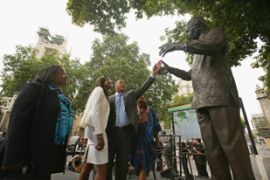Britain honours Mandela with statue
Gordon Brown unveils anti-apartheid leader’s statue in London.

Ken Livingstone, the London mayor, Jesse Jackson, the US civil rights leader, and anti-apartheid activists were among the guests.
Unusually Mandela, who spent 27 years in prison for his struggle against apartheid before becoming South Africa’s first black president in 1994, is being honoured with a statue during his lifetime.
In an address in Westminster Abbey, he said the statue was a tribute he could only dare to have dreamed of.
“Though this statue is of one man, it should … symbolise all those who have resisted oppression, especially in my country,” he said.
“The history of the struggle in South Africa is rich with the stories of heroes and heroines, some of them leaders, some of them followers. All of them deserve to be remembered.”
He recalled that when he and fellow anti-apartheid leader Oliver Tambo visited London in 1962, they had joked that they hoped that “a statue of a black person” would one day be put up next to that of South African Prime Minister Jan Smuts, which stands nearby. The crowd cheered and clapped.
“Oliver would have been proud today if he were here,”
Mandela said he hoped to be back in London next year for an Aids benefit concert marking his 90th birthday.
‘The Great Liberator’
Brown, who called Mandela the “great liberator”, said he would be remembered as “the man who no prison cell, no intimidation, no violence, no show trial, no threat of execution could ever silence”.
|
“The man who no prison cell, no intimidation, no violence, no show trial, no threat of execution could ever silence” Gordon Brown, British prime minister |
The statue was the idea of Donald Woods, the South African anti-apartheid newspaper editor.
After Woods died in 2001, director Richard Attenborough, who made Cry Freedom, a film about Woods’s friendship with black consciousness leader Steve Biko, pushed the project forwards. Woods’ widow, Wendy, was at the ceremony.
The site of the statue was chosen after a five-year row. The local council said it would not be appropriate to place it in Trafalgar Square, site of Nelson’s Column.
The statue was sculpted by the late Ian Walters, chosen in part because of his links to the anti-apartheid movement.